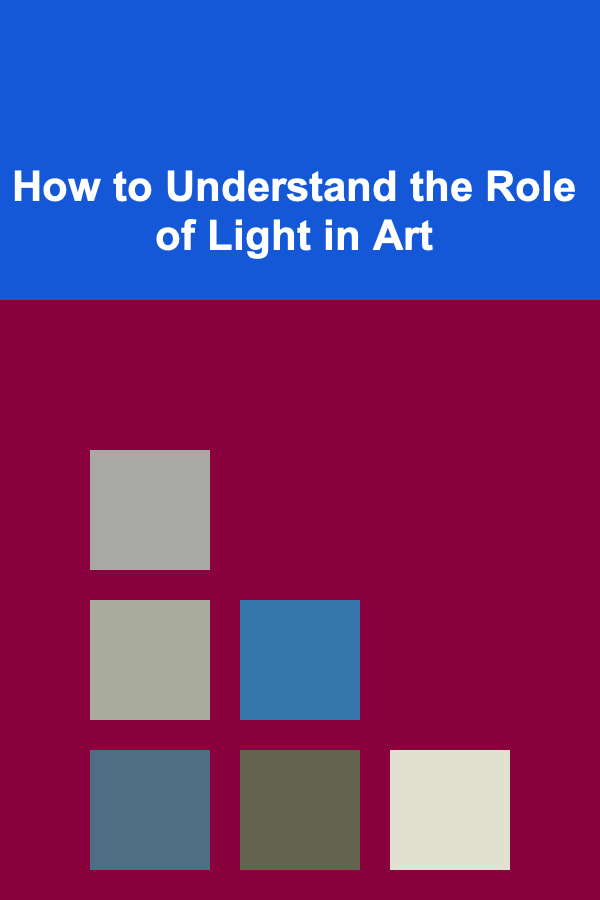
How to Understand the Role of Light in Art
ebook include PDF & Audio bundle (Micro Guide)
$12.99$10.99
Limited Time Offer! Order within the next:

Light is an essential element in the creation of art, shaping how we perceive color, texture, space, and form. Throughout history, artists have experimented with light and shadow to evoke emotions, convey messages, and explore the boundaries of visual perception. From the bright, ethereal qualities of Renaissance masterpieces to the dramatic chiaroscuro of Baroque painting and the use of light in modern photography, light plays a central role in both the technique and interpretation of art. To understand the role of light in art, one must explore its physical properties, its historical context, and its symbolic significance across various artistic movements.
The Physical Properties of Light
At its core, light is a physical phenomenon, a form of electromagnetic radiation that can be perceived by the human eye. It enables the creation of visual images and the differentiation of colors, shapes, and textures. However, light is more than just a means of illuminating objects; it interacts with surfaces and materials in ways that influence how artists manipulate their medium. Understanding the physical properties of light---its direction, intensity, color, and quality---can help an artist harness its full potential in the creation of visual art.
1. Direction of Light
The direction from which light arrives influences how we perceive the form and texture of an object. In art, this is often referred to as the "light source." Depending on where the light source is positioned in relation to the subject, shadows are cast in different directions, and the object's surface features are emphasized or minimized.
- Front Lighting: When light is directed directly in front of a subject, it minimizes shadows and often produces a flat, uniform appearance. This is commonly used in portraiture and still life painting where the artist wants to present a clear, detailed view of the subject.
- Side Lighting: Light coming from the side highlights the contours and texture of the subject, creating dramatic shadows. This can create a sense of depth and volume and is often used in Baroque and classical art to create a sense of drama and emotional intensity.
- Back Lighting: Light that comes from behind the subject can create a halo effect or a silhouette, emphasizing the shape and form of the subject rather than its detail. This technique is often used in modern photography and cinematography to create a sense of mystery or to convey an ethereal quality.
2. Intensity of Light
The intensity of light, or its brightness, affects the mood and atmosphere of a piece of art. High-intensity light creates stark contrasts and is often associated with clarity, purity, or intensity. Low-intensity light, on the other hand, can create a softer, more intimate atmosphere and is often used to evoke a sense of calm or mystery.
In the work of artists like Caravaggio, intense contrasts between light and dark (a technique known as chiaroscuro) are used to heighten emotional intensity, create depth, and focus the viewer's attention on specific areas of the composition. In contrast, Impressionist artists like Claude Monet often utilized softer, diffused light to evoke the feeling of a fleeting moment or a change in the atmosphere.
3. Color of Light
Light is inherently colorless, but the surfaces it strikes can alter its appearance. The color temperature of light refers to whether it has a warm (yellow/red) or cool (blue) tone. Warm light is often associated with sunlight or artificial light sources like candles or lamps, while cool light is more characteristic of daylight or certain types of artificial lighting, such as fluorescent bulbs.
- Warm Light: This type of light is often used in art to create a sense of warmth, comfort, or intimacy. It can give a painting a golden or reddish hue, influencing how the viewer perceives the emotional tone of the work. For example, in the Renaissance, artists used warm light to create a sense of the divine or sacred in religious imagery.
- Cool Light: Cool light, on the other hand, can suggest distance, alienation, or melancholy. In modern art, the use of cool light can add to the perception of isolation or create a sense of the modern world's harshness and industrial nature.
4. Quality of Light
The quality of light refers to its softness or harshness. Hard light comes from a small, intense source (such as the midday sun), producing sharp, well-defined shadows. Soft light, created by a diffused light source (such as overcast sky or shaded light), produces gradual transitions between light and shadow, leading to a smoother, more subtle effect.
Artists use soft light to create a dreamy, serene atmosphere or to depict the subtleties of a subject's texture. Hard light, conversely, is used to create stark contrasts and to emphasize structure, detail, and drama in a composition.
Light in Historical Art Movements
Throughout the history of art, light has been used in different ways to reflect the changing philosophical, cultural, and technological context. Artists have adapted their use of light to align with the shifting values and trends of their time.
1. The Renaissance and the Discovery of Perspective
The Renaissance period marked a significant shift in the use of light in art, as artists began to embrace the principles of linear perspective and naturalism. Artists like Leonardo da Vinci and Michelangelo used light to create a sense of three-dimensionality on a two-dimensional surface, employing soft, even lighting to mimic the effects of natural sunlight.
- Leonardo da Vinci is perhaps one of the most famous artists to explore the relationship between light and human form. In his famous work The Last Supper, he used subtle variations in light and shadow to define the figures of Christ and his apostles, imbuing the scene with a sense of depth and volume.
2. The Baroque and Chiaroscuro
In contrast to the restrained use of light in Renaissance art, the Baroque period was characterized by an intense and dramatic use of light, often referred to as chiaroscuro. Chiaroscuro involves the use of strong contrasts between light and dark to create volume, depth, and emotion.
- Caravaggio is often considered the master of this technique. In his works, such as The Calling of Saint Matthew and Judith Beheading Holofernes, light is used not only to model the human figure but also to create an emotional and spiritual intensity that pulls the viewer into the narrative. The dramatic use of light in these paintings directs the viewer's attention to specific moments in the scene, often heightening the emotional impact.
3. The Impressionist Movement and Natural Light
In the late 19th century, the Impressionists revolutionized the use of light in art, breaking away from the rigid techniques of the academic tradition. Artists like Claude Monet, Pierre-Auguste Renoir, and Édouard Manet sought to capture light as it appeared in nature, painting scenes outdoors (en plein air) to observe the shifting qualities of light at different times of day and under varying atmospheric conditions.
Monet's series of paintings, such as Water Lilies and Haystacks, explore the play of light on different surfaces, emphasizing the fleeting nature of moments. The use of broken color and rapid brushstrokes created an effect where light and color blend together, allowing the viewer to experience a scene's vibrancy as it exists in real time.
4. Modernism and the Role of Light in Abstraction
In the 20th century, Modernist artists began to question traditional representations of light and form, embracing abstraction and the psychological effects of light. Cubists like Pablo Picasso and Georges Braque fragmented the space in their paintings, utilizing light to suggest multiple viewpoints at once. In the works of Surrealists like Salvador Dalí, light was used symbolically to create dreamlike atmospheres and to blur the lines between reality and fantasy.
- Light in Abstract Art: In the works of abstract artists like Wassily Kandinsky and Piet Mondrian, light was used more as an expressive tool, exploring its role in the perception of color and form rather than focusing on its naturalistic depiction.
5. Photography and Light
With the advent of photography in the 19th century, light became even more central to the creation of art. Early photographers like Joseph Nicéphore Niépce and Louis Daguerre experimented with light-sensitive materials to capture images from the real world. The control of light---its exposure, intensity, and direction---became a vital aspect of creating successful photographs.
In contemporary photography, light is used not only to capture reality but to create visual narratives. Photographers like Ansel Adams have mastered the use of light to capture the dramatic beauty of nature, while others like Helmut Newton use light to create mood and intensity in fashion photography.
The Symbolism of Light in Art
Beyond its physical properties, light has always had deep symbolic significance in art. It has been associated with knowledge, purity, spirituality, and transcendence. In many religious and mythological traditions, light symbolizes the divine, often depicted as a source of enlightenment or salvation.
- Religious Art : In Christian art, light is frequently used to represent the presence of God or the divine. In works like the Transfiguration by Raphael, a halo of light surrounds the figures of Christ and his apostles, emphasizing their spiritual significance.
- Romanticism: During the Romantic period, artists used light to convey sublime emotions, often depicting natural landscapes bathed in dramatic light to evoke feelings of awe, mystery, or the power of nature.
Conclusion
Light is a dynamic and multifaceted element in the world of art. Whether through its physical properties---direction, intensity, color, and quality---or its cultural and symbolic meanings, light shapes how artists create and how viewers interpret art. From the masterful chiaroscuro of Baroque painting to the soft, fleeting light of Impressionism, the role of light in art continues to evolve as artists explore new ways to communicate and evoke emotion.
By understanding how light works and how it has been utilized throughout history, we gain deeper insights into the techniques and intentions behind some of the world's greatest artworks. In doing so, we can better appreciate the role light plays in the ever-changing landscape of visual art.

Building an Online Business Using Deep Learning for Passive Income
Read More
How to Create a Checklist for Time Capsule Contents
Read More
How to Plan a Weight Loss Program for Seniors
Read More
How to Reduce Your Debt and Achieve Financial Freedom
Read More
How to Use Blockchain for Decentralized Cloud Computing
Read More
How to Use Coupons and Cashback Apps to Save Money
Read MoreOther Products

Building an Online Business Using Deep Learning for Passive Income
Read More
How to Create a Checklist for Time Capsule Contents
Read More
How to Plan a Weight Loss Program for Seniors
Read More
How to Reduce Your Debt and Achieve Financial Freedom
Read More
How to Use Blockchain for Decentralized Cloud Computing
Read More